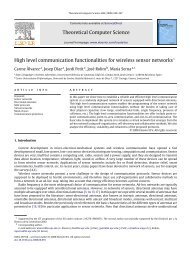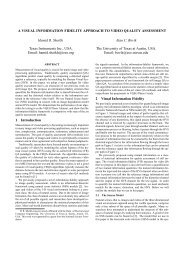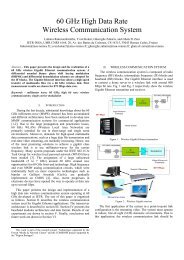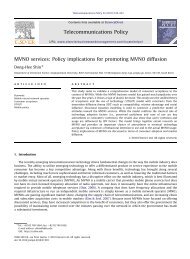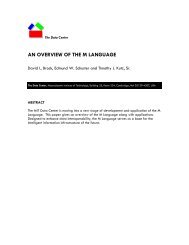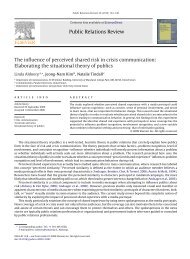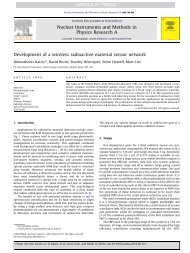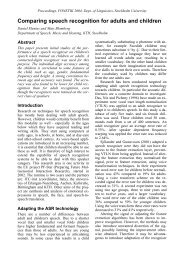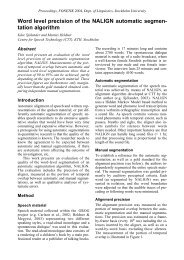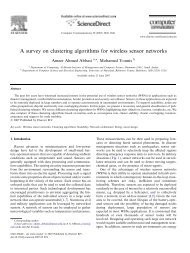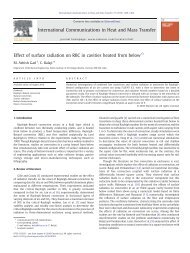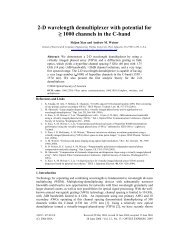Designing a Simulation for Student Evaluation Using Scriven's Key ...
Designing a Simulation for Student Evaluation Using Scriven's Key ...
Designing a Simulation for Student Evaluation Using Scriven's Key ...
Create successful ePaper yourself
Turn your PDF publications into a flip-book with our unique Google optimized e-Paper software.
<strong>Designing</strong> a <strong>Simulation</strong> <strong>Using</strong> Scriven’s <strong>Key</strong> <strong>Evaluation</strong> Checklist e42<br />
and Lashley (2004) gathered student opinions about competency<br />
evaluation using simulation. Three fourths of students<br />
in responding programs reported that competency evaluation<br />
using simulation was appropriate in at least some circumstances.<br />
Universities used<br />
simulation <strong>for</strong> competency<br />
<strong>Key</strong> Points<br />
Use of simulation to<br />
evaluate student per<strong>for</strong>mance<br />
provides<br />
many possibilities.<br />
Scriven’s <strong>Key</strong> <strong>Evaluation</strong><br />
Checklist provides<br />
the structure <strong>for</strong> planning<br />
an evaluation<br />
<strong>Evaluation</strong> with simulation<br />
may more<br />
closely approximate<br />
real world per<strong>for</strong>mance<br />
than traditional<br />
examination<br />
methods<br />
evaluation more often than<br />
community colleges did.<br />
Faculty evaluation of student<br />
per<strong>for</strong>mance was<br />
found to be the primary<br />
evaluation method, with student<br />
report of per<strong>for</strong>mance<br />
second and evaluation of<br />
videotaped per<strong>for</strong>mance<br />
third (Nehring & Lashley,<br />
2004). Radhakrishnan et al.<br />
(2007) described using<br />
simulation to evaluate clinical<br />
skill per<strong>for</strong>mance in<br />
several areas: safety, basic<br />
assessment, prioritization,<br />
problem-focused assessment,<br />
ensuing interventions,<br />
delegation, and communication. Their pilot study, conducted<br />
with nursing students, used a per<strong>for</strong>mance-rating tool measuring<br />
clinical per<strong>for</strong>mance improvement. <strong>Student</strong>s who practiced<br />
using simulation scored higher in per<strong>for</strong>mance rating<br />
than the group using clinical training alone with some identified<br />
skills. Additional studies were recommended.<br />
Scriven’s <strong>Key</strong> <strong>Evaluation</strong> Checklist<br />
Use of simulation in nursing education is rapidly expanding.<br />
With little available evidence about the use of<br />
simulation <strong>for</strong> student evaluation, an established guide<br />
such as Michael Scriven’s <strong>Key</strong> <strong>Evaluation</strong> Checklist<br />
(KEC) has the potential to provide educators with a solid<br />
guiding framework. Scriven, past president of both the<br />
American <strong>Evaluation</strong> Association and the American Educational<br />
Research Association, has published more than<br />
400 articles in many areas, including evaluation (Claremont<br />
Graduate University, 2009). Scriven’s KEC is also well<br />
known <strong>for</strong> contributing to evaluation methodology. As the<br />
KEC is evaluation specific rather than discipline specific,<br />
it has a multidisciplinary focus and can be used in many<br />
areas, such as project evaluation and per<strong>for</strong>mance appraisal<br />
(Davidson, 2005). The KEC provides a useful and established<br />
guide <strong>for</strong> the nurse educator designing an evaluation<br />
of student per<strong>for</strong>mance using simulation.<br />
Many evaluation checklists incorporate a complex theory<br />
or at least a set of assumptions. Scriven’s KEC (Figure 1) consists<br />
of checkpoints representing ‘‘layers’’ in an evaluation. It<br />
is weakly sequential, meaning that it encourages repeated<br />
checkpoint review, which sometimes leads to modification<br />
Scriven’s model.<br />
Preliminaries<br />
Foundations<br />
Sub-<strong>Evaluation</strong>s<br />
I. Executive Summary<br />
II. Preface<br />
III. Methodology<br />
1. Background and Context<br />
2. Descriptions and Definitions<br />
3. Consumers<br />
4. Resources<br />
5. Values<br />
6. Process <strong>Evaluation</strong><br />
7. Outcome <strong>Evaluation</strong><br />
8. & 9.Comparative Cost-Effectiveness<br />
10. Exportability<br />
11. Overall Significance<br />
Conclusions<br />
12. Recommendations and Explanations<br />
13. Responsibilities<br />
14. Reporting and Follow-up<br />
15. Meta-<strong>Evaluation</strong><br />
Note.Used with permission of E. Jane Davidson and Michael Scriven.<br />
Figure 1 Scriven’s model.<br />
of earlier checkpoints (Scriven, 2007b). The effect of repeating<br />
or reviewing checkpoints creates a dynamic, rather than<br />
a static, model. The checklist consists of three preliminary<br />
checkpoints and 15 subsequent checkpoints grouped into<br />
the categories of foundations, sub-evaluations, and conclusions.<br />
These checkpoints provide focus <strong>for</strong> creating, structuring,<br />
and evaluating evaluations of any kind. The checklist<br />
user employs his or her own discretion and judgment in using<br />
the checklist (Davidson, 2005; Scriven, 2007a).<br />
Use of the Checklist When <strong>Designing</strong> a <strong>Simulation</strong><br />
<strong>for</strong> <strong>Evaluation</strong><br />
Davidson (2005) described the first preliminary step in<br />
Scriven’s KEC as the executive summary. This step clarifies<br />
what is going to be evaluated and how. The executive summary<br />
includes descriptions and definitions (also a later<br />
checkpoint) to help identify the student’s current level, as<br />
well as where he or she should be. When the checklist is<br />
used <strong>for</strong> student evaluation, the descriptions-and-definitions<br />
checkpoint would include how simulation is currently being<br />
used in the nursing program, the student’s prior exposure to<br />
simulation, and whether the student has prior evaluation<br />
history with simulation. Scriven’s preface checkpoint of<br />
the KEC describes the big picture <strong>for</strong> the evaluation, that<br />
is, the purpose of the evaluation and the main evaluation<br />
questions (Davidson, 2005). Examples of big-picture questions<br />
might include: Is the simulation to determine whether<br />
a student is progressing adequately during the semester? Is<br />
the simulation to determine skill proficiency? Is it to show<br />
efficient teamwork? and Is it to determine whether a student<br />
should move from one level to the next? The final preliminary<br />
step includes the methodology checkpoint, or simulation<br />
design. In this case, it is the experiential evaluation<br />
provided by simulation, one based on student per<strong>for</strong>mance.<br />
Formative evaluation (evaluation <strong>for</strong> the purpose of<br />
improvement) and summative evaluation (deciding whether<br />
the student (the evaluee) has mastered level objectives) are<br />
pp e41-e44 Clinical <strong>Simulation</strong> in Nursing Volume 6 Issue 2



